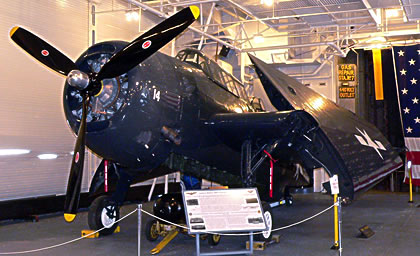
This aircraft is a TBM-3 “Avenger” torpedo bomber. Purchased by the Aircraft Carrier Hornet Foundation in 1998, it has been restored by volunteers with funds provided through donations. This “Avenger” is painted in the squadron markings of VT-17, a squadron that fought from the deck of USS Hornet CV-12 during WWII.
The TBF/TBM was designed to be a replacement for the TBD Devastator. Public unveiling of the plane was scheduled for December 7, 1941. The attack on Pearl Harbor led to naming the aircraft “Avenger”. During WWII the Avenger was regarded as a rugged torpedo plane; used against surface vessels & ground targets in the Pacific. In the Atlantic the Avenger flew primarily as an anti-submarine aircraft. The aircraft was produced in many variations including versions with two wing-mounted .50 cal. guns; with special radar; with cameras for photo recon and searchlights for Anti-Submarine Warfare (ASW), utility, ECM & Carrier On Board Delivery models. After WWII, Avengers served with the Royal Navy, Royal New Zealand Air Force & French Navy. The last TBMs to be retired from active service in 1962 were flown by the Japanese Self Defense Force.
A Shared Linage
VT-17 Aboard USS Hornet 1945
VFA-25 Aboard USS Abraham Lincoln 2003
Torpedo Squadron SEVENTEEN (VT-17) was established 1 January 1943. Redesignated Attack Squadron SIX B (VA-6B) 15 November 1946.
Redesignated Attack Squadron SIXTY-FIVE (VA-65) 27 July 1948. Redesignated Attack Squadron TWENTY-FIVE (VA-25) July 1959.
Redesignated Strike Fighter Squadron TWENTY FIVE (VFA-25) July 1983 (first squadron to be assigned the VFA designation).
7 Apr. 1945: VT-17 based on U.S.S. Hornet CV-12, along with other units from task force 58.1, attacked a Japanese naval force composed of the super-battleship Yamato and her escorts. Facing a heavy onslought of fire, VT-17 aircraft scored the first torpedo hits on the Yamato & sunk one of her destroyer escorts. For their actions in this battle the following squadron personnel were awarded the Navy Cross: Lieutenants T. C. Durkin and S. G. Sullivan; Lt(jg) J. F. Monaghan & Ensign W. F. Nickel. Lieutenant H. E. Clark; Lt(jg) T. J. Coghlan and Ensign R. S. Hanlon were awarded the Silver Star for their actions. All of VT-17’s aircraft did not return, Ensign Leo O’Brien; his gunner, Jacob E. Ricketson; and James L. Opheim, were missing in action.
Operation Iraqi Freedom 2003: VFA-25, based on U.S.S. Abraham Lincoln CVN-72, was part of the longest U.S.Naval deployment in 30 years. With the first strike against targets in Baghdad, VFA-25 began flying 20 combat sorties daily delivering a total of 300,000 lbs. of ordinance which resulted in the destruction of armored divisions, military airfields, facilities and command & control infrastructure.
 The “Fist of the Fleet” squadron insignia and nickname are known around the world. A black fist clenching a red lightning bolt on a field of yellow with three stars representing a war in which “Fist” aircraft have flown –in World War II VT-17 TBM Avengers, in Korea VA-25 AD Skyraiders and in Vietnam VA-25 AD Skyraiders & A-7 Corsair II. With Operation Iraqi Freedom the squadron now has a fourth star.
The “Fist of the Fleet” squadron insignia and nickname are known around the world. A black fist clenching a red lightning bolt on a field of yellow with three stars representing a war in which “Fist” aircraft have flown –in World War II VT-17 TBM Avengers, in Korea VA-25 AD Skyraiders and in Vietnam VA-25 AD Skyraiders & A-7 Corsair II. With Operation Iraqi Freedom the squadron now has a fourth star.
Specifications TBM Avenger
- Crew: Three
- Length: 40 feet (12.2 m)
- Height: 16 feet 5 inches (5 m)
- Wingspan: 54 feet (16.5 m)
- Empty Weight: 10,843 pounds (4,918.4 kg)
- Maximum Weight: 18,250 pounds (8278.2 kg)
- Powerplant: One Wright/Cyclone R-2600-20 with 1,900 horsepower 14 cylinder, air-cooled
- Maximum Range: 1,130 miles with torpedo; 1,920 miles as scout aircraft
- Maximum Speed: 267 m.p.h. at 16,000 feet;
- Service Ceiling: 23,400 feet
- Defensive Armament: Two wing-mounted .50 caliber Colt-Browning M2 machine guns with 335 rounds per gun; one turret-mounted .50 caliber Colt machine gun with 400 rounds; & one tail mounted .30 caliber machine gun with 500 rounds;
- Offensive Armament: In bomb bay: one 22.4 inch Bliss-Leavitt Mark 13 torpedo or Max. 2000 pounds of bombs or depth charges. Eight under-wing mounted 5-inch rockets.



